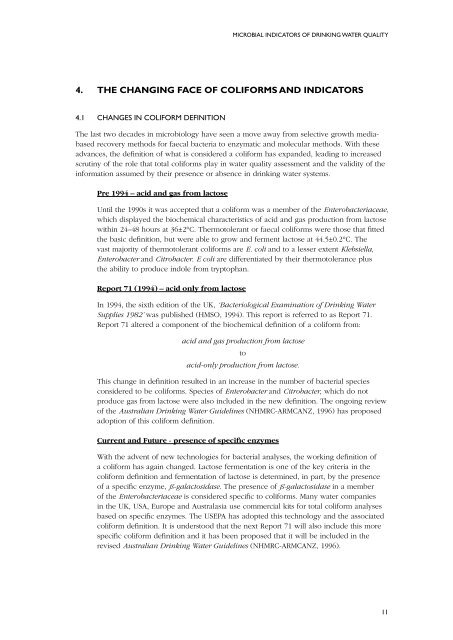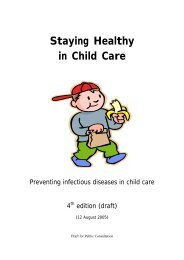Review of Coliforms - National Health and Medical Research Council
Review of Coliforms - National Health and Medical Research Council
Review of Coliforms - National Health and Medical Research Council
You also want an ePaper? Increase the reach of your titles
YUMPU automatically turns print PDFs into web optimized ePapers that Google loves.
MICROBIAL INDICATORS OF DRINKING WATER QUALITY<br />
4. THE CHANGING FACE OF COLIFORMS AND INDICATORS<br />
4.1 CHANGES IN COLIFORM DEFINITION<br />
The last two decades in microbiology have seen a move away from selective growth mediabased<br />
recovery methods for faecal bacteria to enzymatic <strong>and</strong> molecular methods. With these<br />
advances, the definition <strong>of</strong> what is considered a coliform has exp<strong>and</strong>ed, leading to increased<br />
scrutiny <strong>of</strong> the role that total coliforms play in water quality assessment <strong>and</strong> the validity <strong>of</strong> the<br />
information assumed by their presence or absence in drinking water systems.<br />
Pre 1994 – acid <strong>and</strong> gas from lactose<br />
Until the 1990s it was accepted that a coliform was a member <strong>of</strong> the Enterobacteriaceae,<br />
which displayed the biochemical characteristics <strong>of</strong> acid <strong>and</strong> gas production from lactose<br />
within 24–48 hours at 36±2°C. Thermotolerant or faecal coliforms were those that fitted<br />
the basic definition, but were able to grow <strong>and</strong> ferment lactose at 44.5±0.2°C. The<br />
vast majority <strong>of</strong> thermotolerant coliforms are E. coli <strong>and</strong> to a lesser extent Klebsiella,<br />
Enterobacter <strong>and</strong> Citrobacter. E coli are differentiated by their thermotolerance plus<br />
the ability to produce indole from tryptophan.<br />
Report 71 (1994) – acid only from lactose<br />
In 1994, the sixth edition <strong>of</strong> the UK, ‘Bacteriological Examination <strong>of</strong> Drinking Water<br />
Supplies 1982’ was published (HMSO, 1994). This report is referred to as Report 71.<br />
Report 71 altered a component <strong>of</strong> the biochemical definition <strong>of</strong> a coliform from:<br />
acid <strong>and</strong> gas production from lactose<br />
to<br />
acid-only production from lactose.<br />
This change in definition resulted in an increase in the number <strong>of</strong> bacterial species<br />
considered to be coliforms. Species <strong>of</strong> Enterobacter <strong>and</strong> Citrobacter, which do not<br />
produce gas from lactose were also included in the new definition. The ongoing review<br />
<strong>of</strong> the Australian Drinking Water Guidelines (NHMRC-ARMCANZ, 1996) has proposed<br />
adoption <strong>of</strong> this coliform definition.<br />
Current <strong>and</strong> Future - presence <strong>of</strong> specific enzymes<br />
With the advent <strong>of</strong> new technologies for bacterial analyses, the working definition <strong>of</strong><br />
a coliform has again changed. Lactose fermentation is one <strong>of</strong> the key criteria in the<br />
coliform definition <strong>and</strong> fermentation <strong>of</strong> lactose is determined, in part, by the presence<br />
<strong>of</strong> a specific enzyme, ß-galactosidase. The presence <strong>of</strong> ß-galactosidase in a member<br />
<strong>of</strong> the Enterobacteriaceae is considered specific to coliforms. Many water companies<br />
in the UK, USA, Europe <strong>and</strong> Australasia use commercial kits for total coliform analyses<br />
based on specific enzymes. The USEPA has adopted this technology <strong>and</strong> the associated<br />
coliform definition. It is understood that the next Report 71 will also include this more<br />
specific coliform definition <strong>and</strong> it has been proposed that it will be included in the<br />
revised Australian Drinking Water Guidelines (NHMRC-ARMCANZ, 1996).<br />
11

















